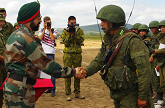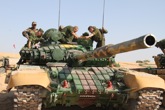Indra-2013: Russian and Indian servicemen destroy a ‘terrorist base’

The Indra-2013 military exercise started on October 18 and officially ended on October 28. Source: Indian Ministry of Defence
The main part of the Indra-2013 military exercise between Russia and India has been completed. It involved the armies of the two countries cooperating and learning how to counter terrorists. The closing ceremony was held on Saturday at the Mahajan firing ground in the Indian state of Rajasthan.
The joint exercises, between the Russian and Indian armies started on October 18. Officially, they ended on October 28, when 250 servicemen of the air assault compounds, which arrived in India from the Eastern Military District, left for home. However, the active phase of the ‘Operation Gangneva’ exercises was completed earlier. Russian and Indian commanders already informed the media about the success of their seventh joint military manoeuvres.
“It is encouraging that the INDRA exercises are already a good tradition,” said Lieutenant-General Vladimir Tsilko, the deputy commander of the Eastern Military District of Russia. “We were honoured to welcome the Indian troops in 2012 on the territory of the Eastern Military District. Then the exercises were held in the heart of Siberia, Republic of Buryatia, not far from Lake Baikal.”
Related:

Indra-2013 to aid India-Russia anti-terror cooperation
Russia to send 250 troops for Indra-2013 drills in India
India remains Russia’s closest strategic partner: Alexander Kadakin
According to the deputy commander, now there are whole groups of military generals, officers, sergeants and soldiers who know and remember each other from their previous work on the Russian territory. Many of them were very happy to meet their old friends here. He also noted the high level of training of the Indian military personnel and their good practical skills with the military equipment.
Under the exercises, the personnel subdivision of the air assault brigade of the Eastern Command blocked off a residential area, held captive by illegal armed groups. After that, the Indian special forces conducted an operation to capture the head of the supposed terrorists.
Having decapitated a gang of terrorists, the men cleared Chidasar of thugs with the help of two Indian military helicopters, where the training took place. The final stage of the operation involved helicopters, tanks, and infantry fighting vehicles, which completed the destruction of the terrorists.
Despite the fact that the visibility conditions were difficult due to fog and heavy dust, both sides showed a high level of interaction and ability to complete combat missions in difficult conditions.
According to Vikram Mohan Chandran, Indian Army Brigadier General, conducting a military operation in the desert was fraught with difficulties such as communication failure, adverse weather conditions and lack of water. During the study, the Russian military operation could learn in practice what it means to fight in the desert.
During the manoeuvres new interaction elements were developed.
This was the first time that the joint planning and management of the anti-terrorist operation was carried out. During the previous training, Indian and Russian officers carried out the planning separately, said Lt. Gen. N S Ghei, who led the exercises on the Indian side. During the operation, the Russian brigade was headed by an Indian commander, and Russian officers were in control of the Indian servicemen, which is also the novelty of these manoeuvres.
According to Rossiyskaya Gazeta, for the Russian servicemen, cultural immersion in India is an equally important part of the training. On Sunday, the Russian servicemen saw some of the local attractions. They went on an excursion to the ancient fort of Bikaner, located near the firing ground.
On Monday, the servicemen will flew home on the airplanes of the Russian military transport aviation.
First published in Russian in Rossiyskaya Gazeta.
Source: videorgru/YouTube
All rights reserved by Rossiyskaya Gazeta.
Subscribe
to our newsletter!
Get the week's best stories straight to your inbox
